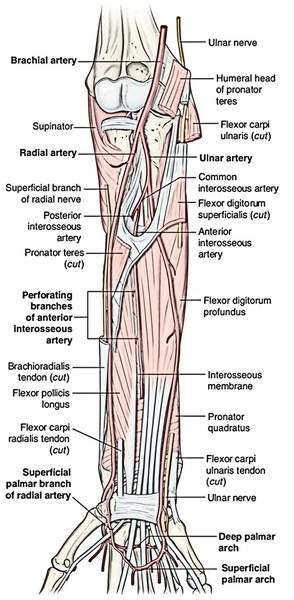The Radial Artery is the main artery in the human forearm. It starts from the brachial artery at roughly the neck of the radius and enters along the lateral aspect of the forearm.
Origin and Course
The radial artery is the smaller terminal branch of the brachial artery. It begins in cubital fossa in the level of the neck of radius. It enters downwards to the wrist with lateral convexity. In the upper part, it is located below the brachioradialis on the deep muscles of the forearm. In the distal part of the forearm, it is located on the anterior surface of the radius and is covered only by the skin and fascia. The superficial radial nerve is located lateral to the middle 1-third of the radial artery. The radial artery leaves the forearm by winding around the lateral aspect of the wrist to reach the anatomical snuff-box on the posterior surface of the hand. It’s further course is described in the hand.
Relations
Anterior
The upper part of the radial artery is overlapped by brachioradialis, while it’s lower part is covered only by the skin, and superficial and deep fasciae.
Posterior
The radial artery from above to downward is located on the following structures:
- Biceps tendon.
- Supinator.
- Pronator teres.
- Flexor digitorum superficialis.
These structures together create the bed of the radial artery.
The radial artery is quite superficial throughout its whole course as compared to the ulnar artery.
Branches in the Forearm
- Muscular branches to the lateral muscles of the forearm.
- Radial recurrent artery originates in the cubital fossa and takes part in the formation of arterial anastomose around the elbow joint.
- Palmar carpal branch, originates near the wrist and anastomosis with the palmar carpal branch of the ulnar artery.
- Superficial palmar branch originates just above the wrist and enters the palm of the hand by passing in front of the flexor retinaculum. It joins the terminal part of the ulnar artery to finish the superficial palmar arch.
Clinical Significance
- Evaluation of radial pulse: It is felt on the radial side of the front of wrist where the radial artery is located on the anterior surface of the distal end of radius, and covered only by the skin and fascia. At this site, the radial artery is located between the tendon of flexor carpi radialis medially and tendon of brachioradialis laterally. While examining the radial pulse, thumb shouldn’t be utilized because of it’s own pulse, which might get mistaken for patient’s pulse. The radial pulse is commonly utilized for examining the pulse rate.
- Volkmann’s ischemic contracture (ischemic compartment syndrome): The sudden complete occlusion (example, because of tight plaster cast) or laceration (because of supracondylar fracture of the humerus) of the brachial artery can cause paralysis of flexor muscles of the forearm because of ischemia inside a few hours. The muscles can tolerate ischemia up to 6 hours only. Thereafter they go through necrosis and fibrous tissue replaces the necrotic tissue. Consequently, muscles shorten permanently producing a flexor deformity characterized by flexion of the wrist, extension of the MP joints, and flexion of the IP joints, which leads to loss of hand power.


 (48 votes, average: 4.67 out of 5)
(48 votes, average: 4.67 out of 5)